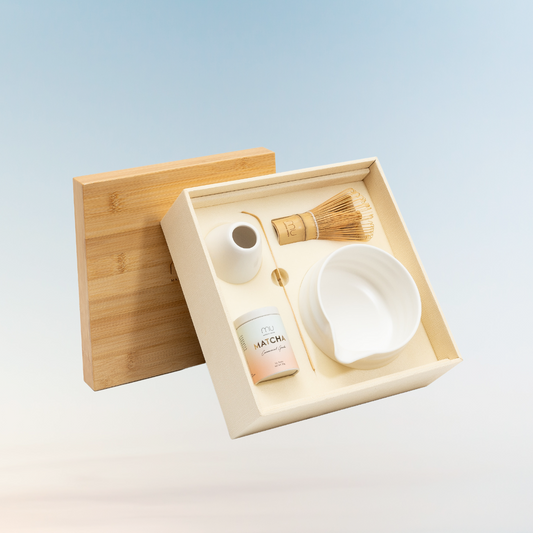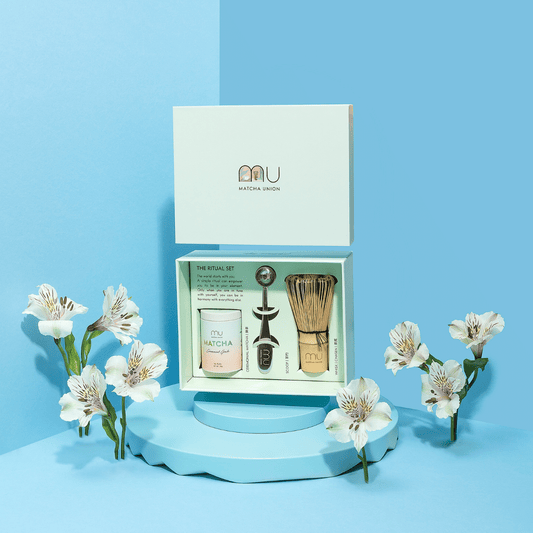
Common errors when making matcha and how to avoid them
Do you struggle mixing your matcha? Are you left with small particles at the bottom of your cup? Did your deep green matcha suddenly become pale? If you answered yes to one of these questions, this article is for you. Here are five common errors you may be making and how to avoid them. Becoming a tea master is easier than you think!
1. The water temperature is wrong.
You may be used to making tea with boiling water - this is not ideal for matcha! Boiling water will "burn" your tea and destroy its nutrients including Vitamin C while caffeine and polyphenols leach out quickly and your matcha becomes bitter and astringent. The best temperature for brewing matcha is 80°C degrees. Higher temperatures will result in bitter flavours and colder temperatures will not produce a dense foam when whisking. The amount of water should be about ¼-⅓ cup for ½-1 tsp of matcha powder. If you are using your eyes for measurement, your tea bowl should be about one quarter full.
2. You are using bad quality matcha.
There are three types of matcha; culinary, premium and ceremonial grade. While brands take pride in labelling their matcha ceremonial grade, consumers can hardly trust the labels. Although there is nothing bad about culinary matcha, it is simply not suited for ceremonial or even latte style drinking. If you are in doubt, always look for a deep green color and Japanese origin without any additives (100% matcha green tea powder).
The price for reputable ceremonial grades can range from £18 to £50 for 30g. A high quality matcha is intense in color with floral layers of sweetness, and umami - it should not be bitter. Our Ceremonial Grade uses 1st-harvest leaves, the most tender leaves from the farms of Uji, Kyoto- Japan’s most ancient city. If you’d like to have a deeper insight into how to choose the best matcha and why we offer two grades of matcha, click here.
Always opt for certified organic or sustainably sourced matcha from small farms. Uncertified matcha can do more harm than good to your body. It will produce a lot of sediment and lumps when brewed and can contain dangerous toxins and heavy metals.
3. Not using the right amount of matcha powder.
The amount of matcha powder used is crucial to brewing the perfect cup of matcha. Matcha is made from green tea leaves ground into powder. Therefore, a little matcha powder goes a long way and its dosage is very personal. It's common to use 1 teaspoon or 2 grams of matcha powder. This will give you a rich matcha especially if prepared with water only. If you are new to matcha you can start with ½ teaspoon or one serving of our matcha scoop and work your way up. Just remember to add the right amount of water (¼-⅓ cup) and the right amount of milk (½-⅔ cup) depending on whether you serve it over ice or hot. Try testing different proportions and find the perfect recipe for yourself.
4. Mixing matcha in a wrong way.
Matcha powder is a suspension and does not "dissolve" in water. A simple stir with a spoon or fork won't do the job. The best way to mix matcha and water is to use a traditional bamboo whisk. A matcha whisk, also known as chasen, is an important part of the Japanese tea ceremony and preparation of matcha. The traditional tool is crafted from a single bamboo block that is finely cut into the desired shape and string count. At Matcha Union our whisks have 100 prongs to allow for the best mix of matcha powder, water and air to create a frothy drink with a smooth texture and sweet aroma. We like to massage the matcha powder with a splash of water into a smooth paste, before adding more water for whisking the mixture into a frothy drink. This ensures that no lumps are left. You can learn more about how to use and why we recommend this tool here.
If you do not own a bamboo whisk, we recommend the following methods:
1. Shake a water bottle. Add water and matcha to a water bottle. Then shake it vigorously for a minute.
2. Use a milk frother (handheld or standing). Simply add matcha and milk (heated if desired) and froth until smooth. With a handheld frother you can whisk water and matcha first and the milk separately and then add the two together.
3. Use a blender. Add milk (heated if desired) and matcha to a blender and blend on high for 30s until smooth and frothy. Pour over ice or enjoy warm.
Nonetheless, our bamboo whisk allows for the best mix of matcha powder, water, and air while releasing aromas and essences in the foam on the surface. It is not only about mixing the powder with water, but also an oxygenation process of increasing the taste.
Avoid silver and metal tools as these can affect the taste of your matcha.
5. Storing matcha in a wrong way.
Matcha powder is very delicate and needs to be stored carefully before and after opening the package. We recommend to store unopened packs in the freezer and opened packs in the fridge. They should be tightly sealed to prevent moisture and light exposure. This will ensure that the flavour, colour and nutrients of your matcha will not deteriorate through oxidation. Try to consume an opened pack within one month of opening. Closed packs can stay fresh up to 8 months.
Need more help? Contact us!
We hope that we have solved your matcha problems in this article. If you have any further questions contact us through instagram or email us at info@matchaunion.com. We want to make sure you brew the best cup of matcha every time!






2 comments
Vielen Dank für deine Frage, Freya! Frisch zubereiteter Matcha ist am besten, da die Nährstoffe – insbesondere die wertvollen Antioxidantien wie Catechine – nach der Zubereitung durch Licht, Luft und Wärme langsam abgebaut werden.
Wenn du deinen Matcha im Kühlschrank in einem verschlossenen Behälter aufbewahrst, kannst du ihn innerhalb von 24 Stunden trinken, ohne dass zu viele Nährstoffe verloren gehen. Nach 1-2 Tagen nimmt der Nährstoffgehalt jedoch deutlich ab, und auch der Geschmack kann sich verändern.
Für die maximale Wirkung und den besten Geschmack empfehlen wir, Matcha immer frisch zu genießen! 😊🍵
Vielen Dank für die interessanten Artikel ich habe trotzdem noch eine Frage und zwar kann ich zubereiteten Matcha meistens mit hafermilch auch im Kühlschrank mehrere Tage aufbewahren?
Oder gehen dann all seine Vorteile verloren?
Liebe Grüße